Heinrich J.G., Aldinger F. (Eds.) Ceramic Materials and Components for Engines
Подождите немного. Документ загружается.

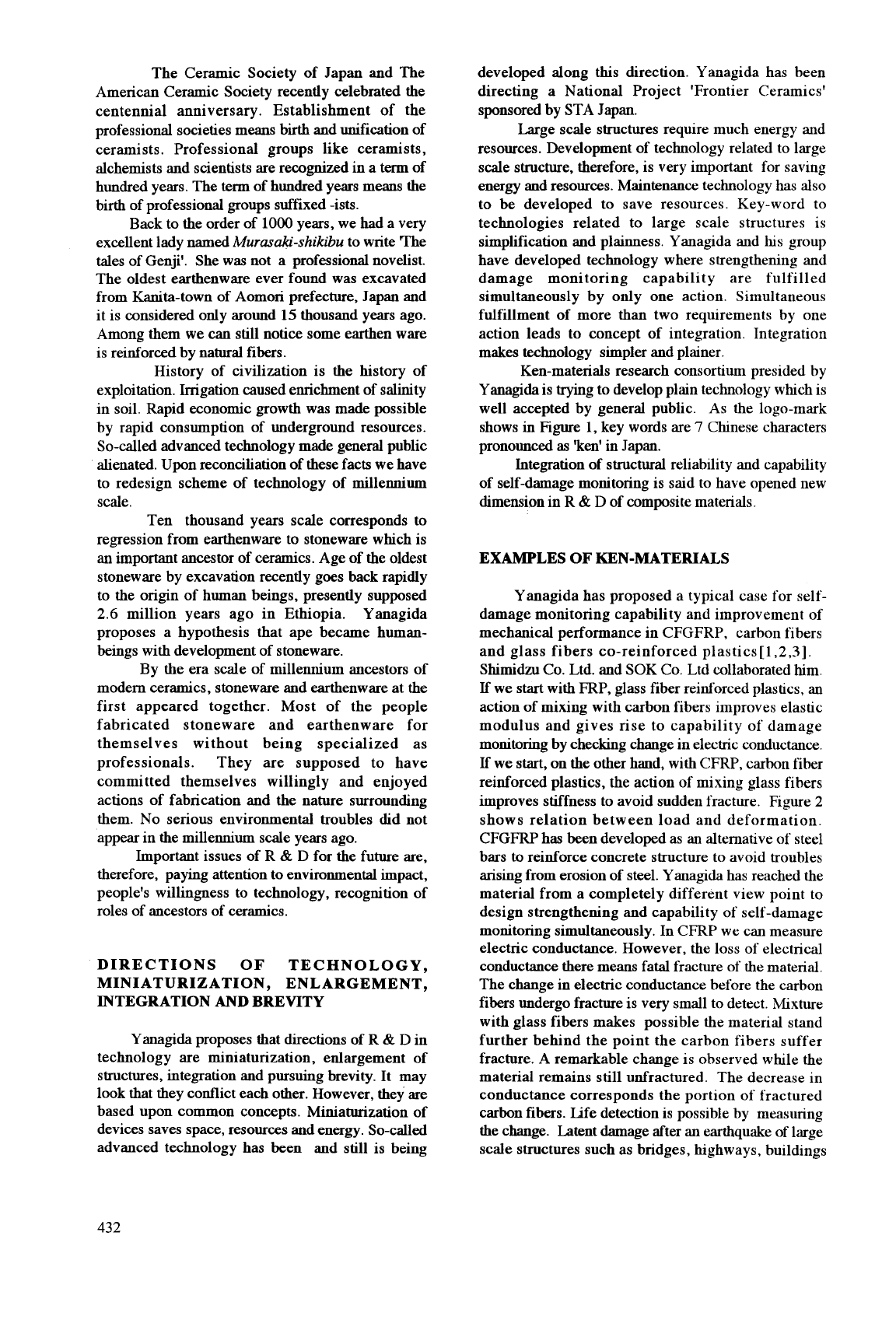
The Ceramic Society of Japan and The
American Ceramic Society recently celebrated the
centennial anniversary. Establishment of the
professional societies means birth and unification of
ceramists. Professional groups like ceramists,
alchemists and scientists are recognized in a term of
hundred years. The term of hundred years means the
birth of professional groups suffixed -ists.
Back to the order of
1000
years, we had a very
excellent lady named
Murasuki-shikibu
to write The
tales of Genji'. She was not a professional novelist.
The oldest earthenware ever found was excavated
from Kanita-town of Aomori prefecture, Japan and
it is considered only around
15
thousand years ago.
Among them we
can
still notice some earthen ware
is reinforced by natural fibers.
History of civilization is the history of
exploitation. Imgation caused enrichment of salinity
in soil. Rapid economic growth was made possible
by rapid consumption of underground resources.
So-called advanced technology made general public
alienated. Upon reconciliation of these facts we have
to redesign scheme of technology of millennium
scale.
Ten
thousand years scale corresponds to
regression from earthenware to stoneware which is
an important ancestor of ceramics. Age of the oldest
stoneware by excavation recently goes back rapidly
to the origin of human beings, presently supposed
2.6
million years ago in Ethiopia.
Yanagida
proposes a hypothesis that ape became human-
beings with development of stoneware.
By the era scale of millennium ancestors of
modem ceramics, stoneware and earthenware at the
first appeared together.
Most of the people
fabricated stoneware and earthenware for
themselves without being specialized as
professionals. They are supposed to have
committed themselves willingly and enjoyed
actions of fabrication and the nature surroundmg
them.
No
serious environmental troubles did not
appear in the millennium scale years ago.
Important issues of
R
&
D
for the future are,
therefore, paying attention to environmental impact,
people's willingness to technology, recognition of
roles of ancestors of ceramics.
DIRECTIONS
OF
TECHNOLOGY,
MINIATURIZATION, ENLARGEMENT,
INTEGRATION
AND
BREVITY
Y
anagida proposes that directions of
R
&
D in
technology are miniaturization, enlargement of
structures, integration and pursuing brevity.
It
may
look
that
they conflict each other. However, they are
based upon common concepts. Miniaturization of
devices saves space, resources and energy. So-called
advanced technology has been and still is being
developed along
this
direction. Yanagida has been
directing a National Project 'Frontier Ceramics'
sponsored by STA Japan.
Large scale structures require much energy and
resources. Development of technology related to large
scale structure, therefore, is very important for saving
energy and resources. Maintenance technology has also
to be developed to save resources. Key-word to
technologies related to large scale structures is
simplification and plainness. Yanagida and
hs
group
have developed technology where strengthening and
damage monitoring capability are fulfilled
simultaneously by only one action. Simultaneous
fulfillment of more than two requirements by one
action leads to concept of integration. Integration
makes technology simpler and plainer.
Ken-materials research consortium presided by
Yanagida is trying to develop plain technology whch
is
well accepted by general public.
As
the logo-mark
shows
in
Figure
1,
key words are
7
Chinese characters
pronounced
as
'ken' in Japan.
Integration of structural reliability and capability
of self-damage monitoring is said to have opened new
dimension in R
&
D
of composite materials.
EXAMPLES
OF
KEN-MATERIALS
Yanagida has proposed a typical case for self-
damage monitoring capability and improvement of
mechanical performance in CFGFRP, carbon fibers
and glass fibers co-reinforced plastics[l,2,3].
Shmidzu Co. Ltd. and SOK
Co.
Ltd collaborated hlm.
If
we
start
with FRP, glass fiber reinforced plastics,
an
action of mixing with carbon fibers improves elastic
modulus and gives rise to capability
of
damage
monitoring by checking change in electric conductance.
If
we
start,
on
the other hand, with CFRP, carbon fiber
reinforced plastics, the action of mixing glass fibers
improves stiffness to avoid sudden fracture. Figure
2
shows relation between load and deformation.
CFGFRP has been developed as
an
alternative
of
steel
bars to reinforce concrete structure to avoid troubles
arising from erosion of steel. Yanagida has reached the
material from a completely different view point to
design strengthening and capability of self-damage
monitoring simultaneously. In CFRP
we
can measure
electric conductance. However, the loss of electrical
conductance there means fatal fracture of the material.
The change
in
electric conductance before the carbon
fibers undergo fracture is very small to detect. Mixture
with glass fibers makes possible the material stand
further behind the point the carbon fibers suffer
fracture.
A
remarkable change is observed whle the
material remains still unfractured. The decrease
in
conductance corresponds the portion of fractured
carbon fibers. Life detection
is
possible by measuring
the change. Latent damage after
an
earthquake of large
scale structures such as bridges, highways, buildings
432
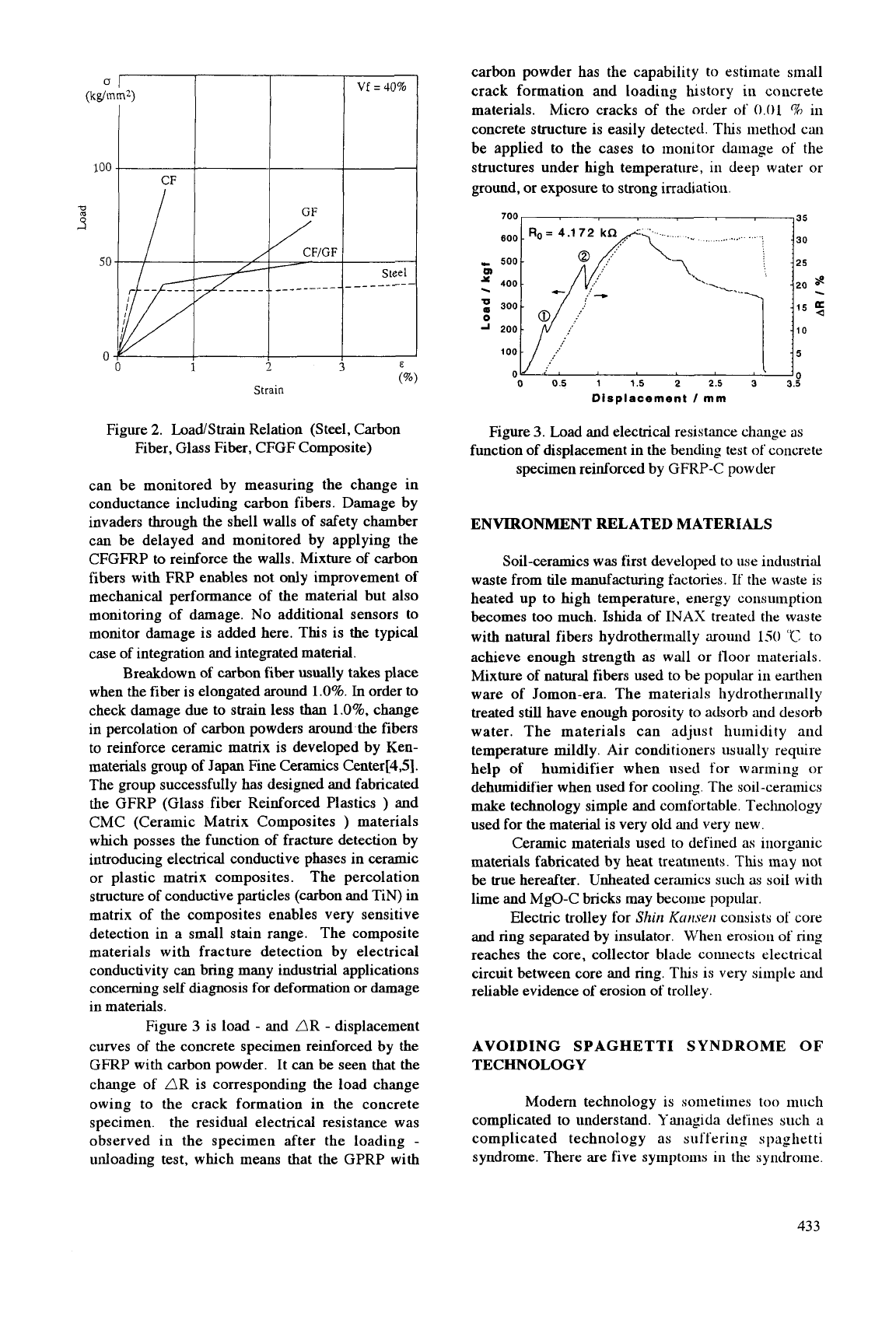
carbon powder has the capability to estimate small
crack formation and loading hstory in concrete
materials. Micro cracks of the order of
0.01
CTO
in
concrete structure is easily detected. This method can
be applied to the cases to moiiitor damage of the
structures under high temperature, in deep water or
ground, or exposure to
strong
irradiation.
700
35
6oo
Ro
=
4.1
72
kQ/y
.
. .
._.,
,
.,.__......
.
.
.?
:
30
0
i
3
Strain
Displacement
I
rnm
Figure
2.
LoadlStrain Relation (Steel, Carbon
Fiber, Glass Fiber, CFGF Composite)
can be monitored by measuring the change in
conductance includmg carbon fibers. Damage by
invaders through the shell walls of safety chamber
can be delayed and monitored by applying the
CFGFRP to reinforce the walls. Mixture of carbon
fibers with FRP enables not only improvement of
mechanical performance of the material but also
monitoring of damage. No additional sensors to
monitor damage is added here. This is the typical
case of integration and integrated material.
Breakdown of carbon fiber usually takes place
when the fiber is elongated around
1.0%.
In
order to
check damage due to strain less than
1.0%,
change
in percolation of carbon powders around the fibers
to reinforce ceramic matrix is developed by Ken-
materials group of Japan Fine Ceramics Center[4,5].
The group successfully has designed and fabricated
the GFRP (Glass fiber Reinforced Plastics
)
and
CMC (Ceramic Matrix Composites
)
materials
which posses the function of fracture detection by
introducing electrical conductive phases in ceramic
or
plastic matrix composites. The percolation
structure of conductive particles (carbon and TIN) in
matrix
of
the composites enables very sensitive
detection in a small stain range. The composite
materials with fracture detection by electrical
conductivity can bring many industrial applications
concerning self diagnosis
for
deformation or damage
in materials.
Figure
3
is
load
-
and AR
-
displacement
curves of the concrete specimen reinforced by the
GFRP with carbon powder. It
can
be seen that the
change of AR is corresponding the load change
owing to the crack formation in the concrete
specimen. the residual electrical resistance was
observed in the specimen after the loading
-
unloading test, which means that the GPRP with
Figure
3.
Load and electrical resistance change
as
function of displacement in the bending test of concrete
specimen reinforced by
GFRP-C
powder
ENVIRONMENT RELATED MATERIALS
Soil-ceramics was first developed to use industrial
waste from tile manufacturing factories. If the waste is
heated up to high temperature, energy consumption
becomes too much. Ishida of INAS treated the waste
with natural fibers hydrothermally around
150
'C
to
acheve enough strength as wall or floor materials.
Mixture of natural fibers used to be popular in earthen
ware of Jomon-era. The materials hydrothermally
treated
still
have enough porosity to adsorb
and
desorb
water. The materials can adjust humidity and
temperature mildly. Air conditioners usually require
help of humidifier when used for warming or
dehumidifier when used for cooling. The soil-ceramics
make technology simple and comfortable. Technology
used for the material is very old and very new.
Ceramic materials used to defined
as
inorganic
materials fabricated by heat treatments. This inay not
be true hereafter. Unheated ceramics such
as
soil with
lime and MgO-C bricks may become popular.
Electric trolley for
Shin
Kcrirsrn
consists of core
and ring separated by insulator.
\.Tihen
erosion of ring
reaches the core, collector blade connects electrical
circuit between core and ring. This is very simple atid
reliable evidence
of
erosion of trolley.
AVOIDING SPAGHETTI SYNDROME
OF
TECHNOLOGY
Modern technology is sometiines too much
complicated to understand. Yariagida defines such
ii
complicated technology
as
suffering spaghetti
syndrome. There are five symptoms in the synclroine.
433
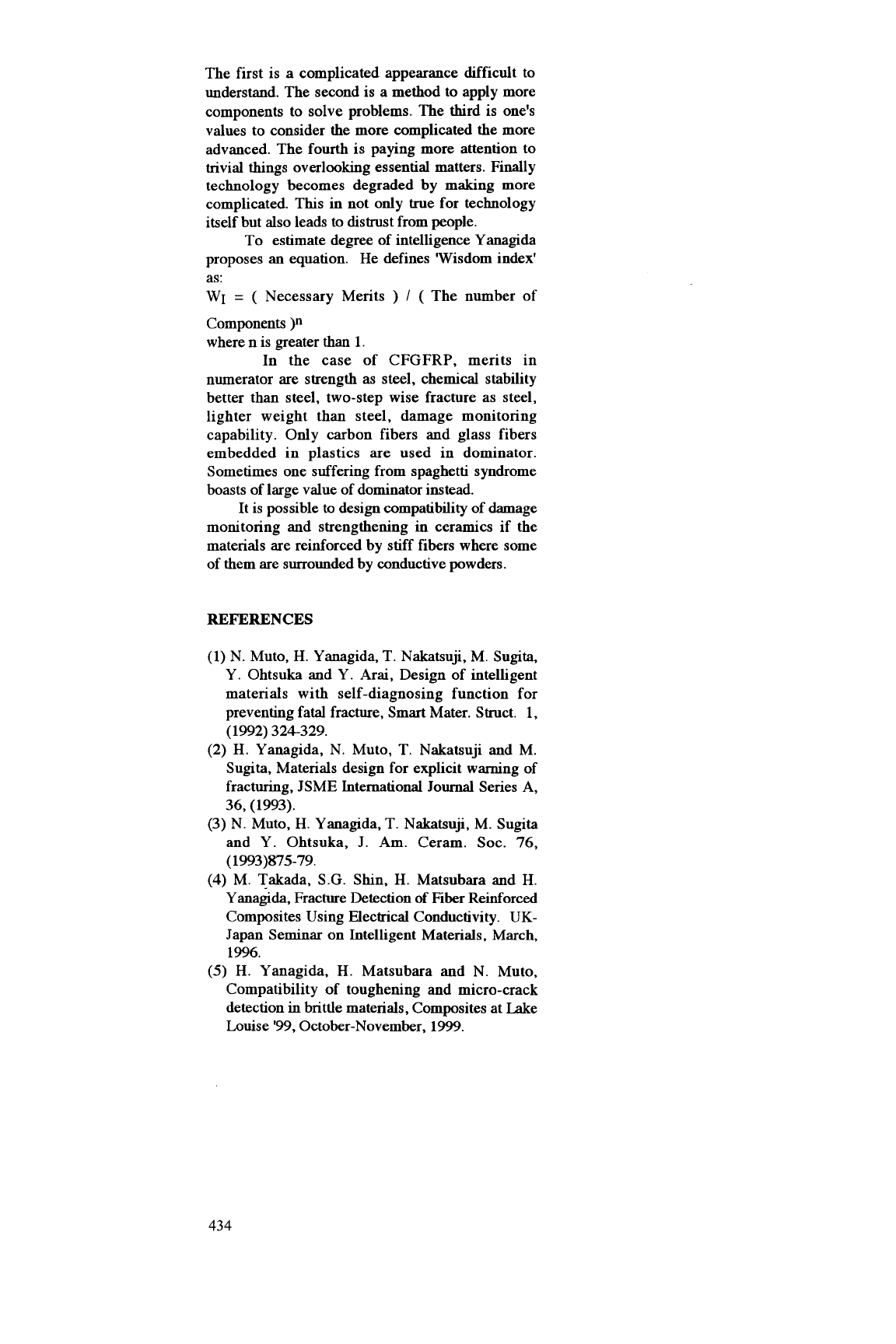
The first is a complicated appearance dfficult to
understand. The second is a method to apply more
components to solve problems. The third is one's
values to consider the more complicated the more
advanced. The fourth is paying more attention to
trivial
things
overlooking essential matters. Finally
technology becomes degraded by making more
complicated. This in not only true for technology
itself but also leads to distrust from people.
To estimate degree of intelligence Yanagida
proposes an equation. He defines 'Wisdom index'
as:
WI
=
(
Necessary Merits
)
I
(
The number of
Components
)n
where
n
is greater than
1.
In
the case of CFGFRP, merits in
numerator are strength
as
steel, chemical stability
better than steel, two-step wise fracture as steel,
lighter weight than steel, damage monitoring
capability. Only carbon fibers and glass fibers
embedded in plastics are used in dominator.
Sometimes one suffering from spaghetti syndrome
boasts of large value of dominator instead.
It is possible to design compatibility of damage
monitoring and strengthening
in
ceramics
if
the
materials are reinforced by stiff fibers where some
of them are surrounded by conductive powders.
REFERENCES
(1)
N.
Muto, H. Yanagida, T. Nakatsuji, M. Sugita,
Y.
Ohtsuka and Y. Arai, Design of intelligent
materials with self-diagnosing function for
preventing fatal fracture, Smart Mater. Struct.
1,
(2)
H. Yanagida, N. Muto,
T.
Nakatsuji and M.
Sugita, Materials design for explicit warning of
fracturing, JSME International
Journal
Series A,
36, (1993).
(3)
N.
Muto, H. Yanagida, T. Nakatsuji, M. Sugita
and Y. Ohtsuka,
J.
Am. Ceram. SOC.
76,
(1993)875-79.
(4)
M. Takada, S.G. Shin,
H.
Matsubara and H.
Y
auasda, Fracture Detection of Fiber Reinforced
Composites Using Electrical Conductivity.
UK-
Japan Seminar
on
Intelligent Materials, March,
1996.
(5)
H. Yanagida, H. Matsubara and
N.
Muto,
Compatibility of toughening and micro-crack
detection
in
brittle materials, Composites at Lake
Louise
'99,
October-November,
1999.
(1992) 324-329.
434
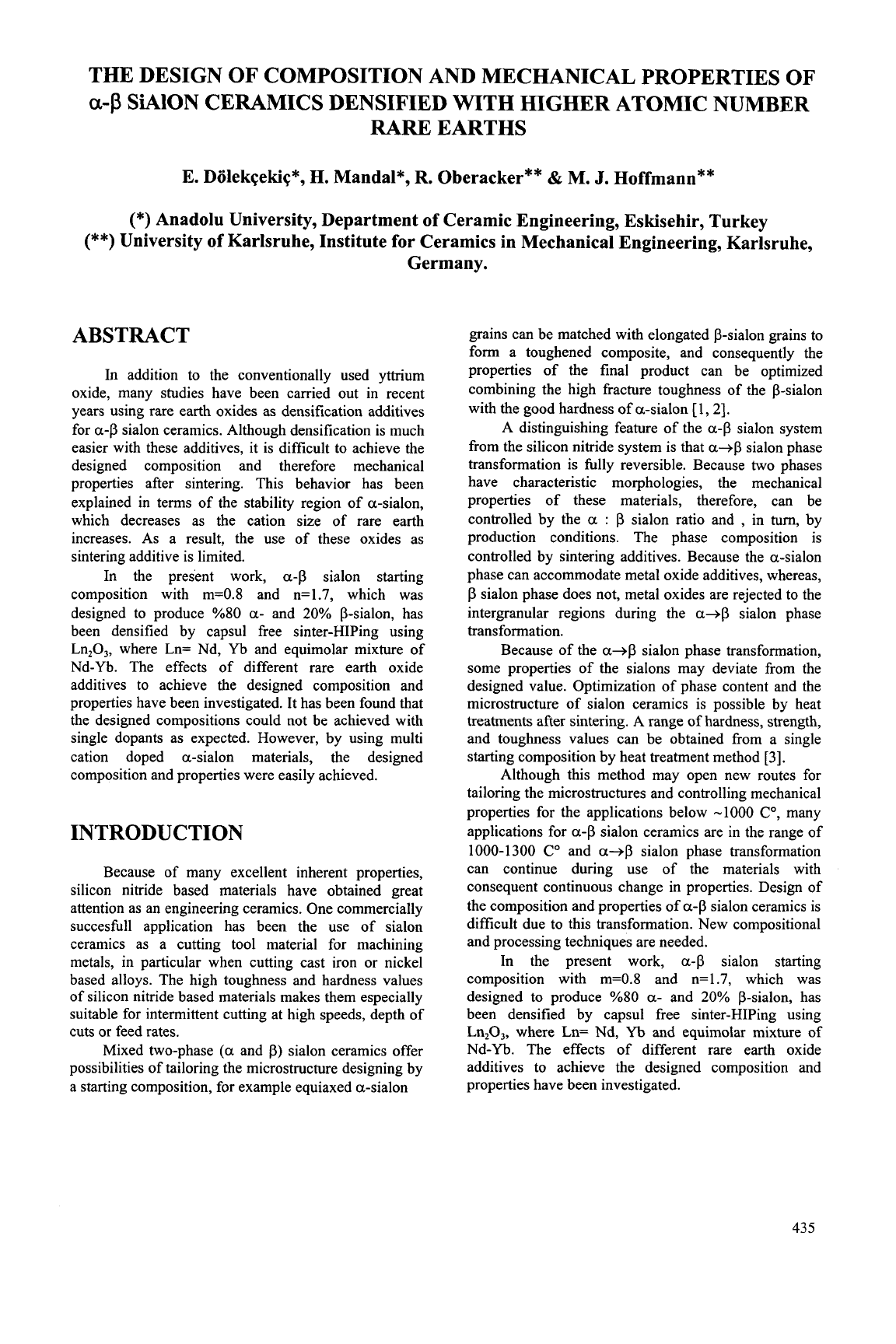
THE DESIGN OF COMPOSITION AND MECHANICAL PROPERTIES OF
RARE
EARTHS
a-p
SiAlON CERAMICS DENSIFIED WITH HIGHER ATOMIC NUMBER
E. Dolekqekiq*,
H.
Mandal*,
R.
Oberacker**
&
M.
J.
Hoffmann**
(*)
Anadolu University, Department
of
Ceramic Engineering, Eskisehir, Turkey
(**)
University of Karlsruhe, Institute for Ceramics in Mechanical Engineering, Karlsruhe,
Germany.
ABSTRACT
In addition to the conventionally used yttrium
oxide, many studies have been carried out in recent
years using rare earth oxides as densification additives
for
a-P
sialon ceramics. Although densification is much
easier with these additives, it is difficult to achieve the
designed composition and therefore mechanical
properties after sintering. This behavior has been
explained in terms of the stability region of a-sialon,
which decreases as the cation size of rare earth
increases. As a result, the use of these oxides as
sintering additive is limited.
In the present work,
a-P
sialon starting
composition with m=0.8 and n=1.7, which was
designed to produce
%80
a-
and
20%
p-sialon, has
been densified by capsul free sinter-HIPing using
Ln,O,, where Ln= Nd, Yb and equimolar mixture
of
Nd-Yb. The effects of different rare earth oxide
additives to achieve the designed composition and
properties have been investigated. It has been found that
the designed compositions could not be achieved with
single dopants as expected. However, by using multi
cation doped a-sialon materials, the designed
composition and properties were easily achieved.
INTRODUCTION
Because of many excellent inherent properties,
silicon nitride based materials have obtained great
attention as an engineering ceramics. One commercially
succesfull application has been the use of sialon
ceramics as a cutting tool material for machining
metals, in particular when cutting cast iron
or
nickel
based alloys. The high toughness and hardness values
of silicon nitride based materials makes them especially
suitable for intermittent cutting at high speeds, depth of
cuts
or
feed rates.
Mixed hvo-phase (a and
p)
sialon ceramics offer
possibilities of tailoring the microstructure designing by
a starting composition, for example equiaxed a-sialon
grains can be matched with elongated P-sialon grains to
form a toughened composite, and consequently the
properties of the final product can be optimized
combining the high fracture toughness of the p-sialon
with the good hardness of a-sialon
[
1,2].
A distinguishing feature of the
a-p
sialon system
from the silicon nitride system is that
a+
sialon phase
transformation is fully reversible. Because
two
phases
have characteristic morphologies, the mechanical
properties of these materials, therefore, can be
controlled by the
a
:
p
sialon ratio and
,
in turn, by
production conditions. The phase composition is
controlled by sintering additives. Because the a-sialon
phase can accommodate metal oxide additives, whereas,
p
sialon phase does not, metal oxides are rejected to the
intergranular regions during the
a+
sialon phase
transformation.
Because of the
a+$
sialon phase transformation,
some properties
of
the sialons may deviate from the
designed value. Optimization of phase content and the
microstructure of sialon ceramics is possible by heat
treatments after sintering.
A
range of hardness, strength,
and toughness values can be obtained from a single
starting composition by heat treatment method [3].
Although this method may open new routes for
tailoring the microstructures and controlling mechanical
properties for the applications below -1000
C",
many
applications for
a-p
sialon ceramics are in the range
of
1000-1300
C"
and
a+p
sialon phase transformation
can continue during use of the materials with
consequent continuous change in properties. Design of
the composition and properties of
a-p
sialon ceramics is
difficult due to this transformation. New compositional
and processing techniques are needed.
In the present work,
a-p
sialon starting
composition with m=O.8 and n=1.7, which was
designed to produce
%80
a-
and
20%
p-sialon, has
been densified by capsul free sinter-HIPing using
Ln,O,, where
Ln=
Nd,
Yb
and
equimolar mixture of
Nd-Yb. The effects of different rare earth oxide
additives to achieve the designed composition and
properties have been investigated.
435
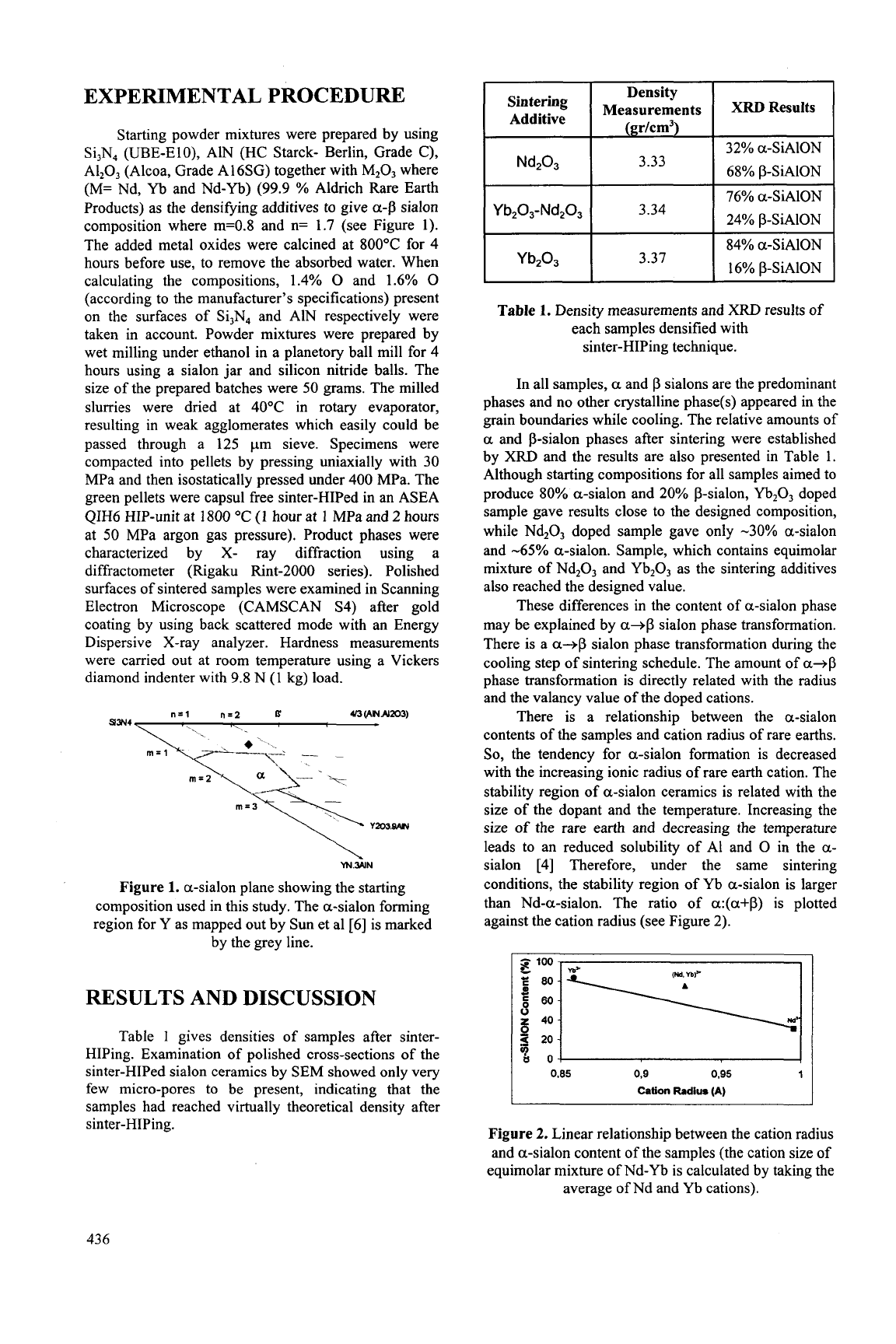
EXPERIMENTAL PROCEDURE
Starting powder mixtures were prepared by using
Si,N, (UBE-ElO), A1N (HC Starck- Berlin, Grade C),
A1,0, (Alcoa, Grade A1 6SG) together with M203 where
(M= Nd,
Yb and Nd-Yb)
(99.9
%
Aldrich Rare Earth
Products) as the densifying additives
to
give
a-/3
sialon
composition where m=0.8 and n= 1.7 (see Figure 1).
The added metal oxides were calcined at 800°C for 4
hours before use, to remove the absorbed water. When
calculating the compositions, 1.4%
0
and 1.6%
0
(according to the manufacturer's specifications) present
on the surfaces of Si,N, and AIN respectively were
taken in account. Powder mixtures were prepared by
wet milling under ethanol in a planetory ball mill for 4
hours using a sialon jar and silicon nitride balls. The
size of the prepared batches were
50
grams. The milled
slurries were dried at 40°C in rotary evaporator,
resulting in weak agglomerates which easily could be
passed through a 125 pm sieve. Specimens were
compacted into pellets by pressing uniaxially with 30
MPa and then isostatically pressed under 400 MPa. The
green pellets were capsul free sinter-HIPed in an ASEA
QIH6 HIP-unit at
1800
"C
(1
hour at
1
MPa and 2 hours
at
50
MPa argon gas pressure). Product phases were
characterized by
X-
ray diffraction using a
diffractometer (Rigaku Rint-2000 series). Polished
surfaces of sintered samples were examined in Scanning
Electron Microscope (CAMSCAN
S4)
after gold
coating by using back scattered mode with an Energy
Dispersive X-ray analyzer. Hardness measurements
were carried out at room temperature using a Vickers
diamond indenter with
9.8 N
(1
kg) load.
\
W."
Figure
1.
a-sialon plane showing the starting
composition used in this study. The a-sialon forming
region for
Y
as mapped out by Sun et a1 [6] is marked
by the grey line.
RESULTS AND DISCUSSION
Table
1
gives densities of samples after sinter-
HIPing. Examination of polished cross-sections of the
sinter-HIPed sialon ceramics
by
SEM showed only very
few micro-pores
to
be present, indicating that the
samples had reached virtually theoretical density after
sinter-HIPing.
Sintering Density
Additive
32% a-SiAlON
68% B-SiAlON
76% a-SiAlON
24% P-SiAlON
I
Yb203-Nd203
I
3.34
I
84% a-SiAlON
16% P-SiAlON
Table
1.
Density measurements and
XRD
results
of
each samples densified with
sinter-HIPing technique.
In all samples,
a
and
p
sialons are the predominant
phases and no other crystalline phase(s) appeared in the
grain boundaries while cooling. The relative amounts of
a
and P-sialon phases after sintering were established
by
XRD
and the results are also presented in Table
1.
Although starting compositions for all samples aimed to
produce
80%
a-sialon and 20% p-sialon,
Yb203
doped
sample gave results close to the designed composition,
while
Nd20,
doped sample gave only
-30%
a-sialon
and
-65%
a-sialon. Sample, which contains equimolar
mixture of Nd203 and Yb203 as the sintering additives
also reached the designed value.
These differences in the content of a-sialon phase
may be explained by
a++
sialon phase transformation.
There is a
a+
sialon phase transformation during the
cooling step of sintering schedule. The amount of
a+
phase transformation is directly related with the radius
and the valancy value of the doped cations.
There is a relationship between the a-sialon
contents of the samples and cation radius of rare earths.
So,
the tendency for a-sialon formation is decreased
with the increasing ionic radius of rare earth cation. The
stability region of a-sialon ceramics is related with the
size of the dopant and the temperature. Increasing the
size of the rare earth and decreasing the temperature
leads to an reduced solubility of A1 and
0
in the
a-
sialon [4] Therefore, under the same sintering
conditions, the stability region of Yb a-sialon is larger
than Nd-a-sialon. The ratio of a:(a+p) is plotted
against the cation radius (see Figure 2).
0.85
0,9
0.95
I
Cation
Radius
(A)
Figure
2.
Linear relationship between the cation radius
and a-sialon content of the samples (the cation size of
equimolar mixture of Nd-Yb is calculated by taking the
average of Nd and Yb cations).
436
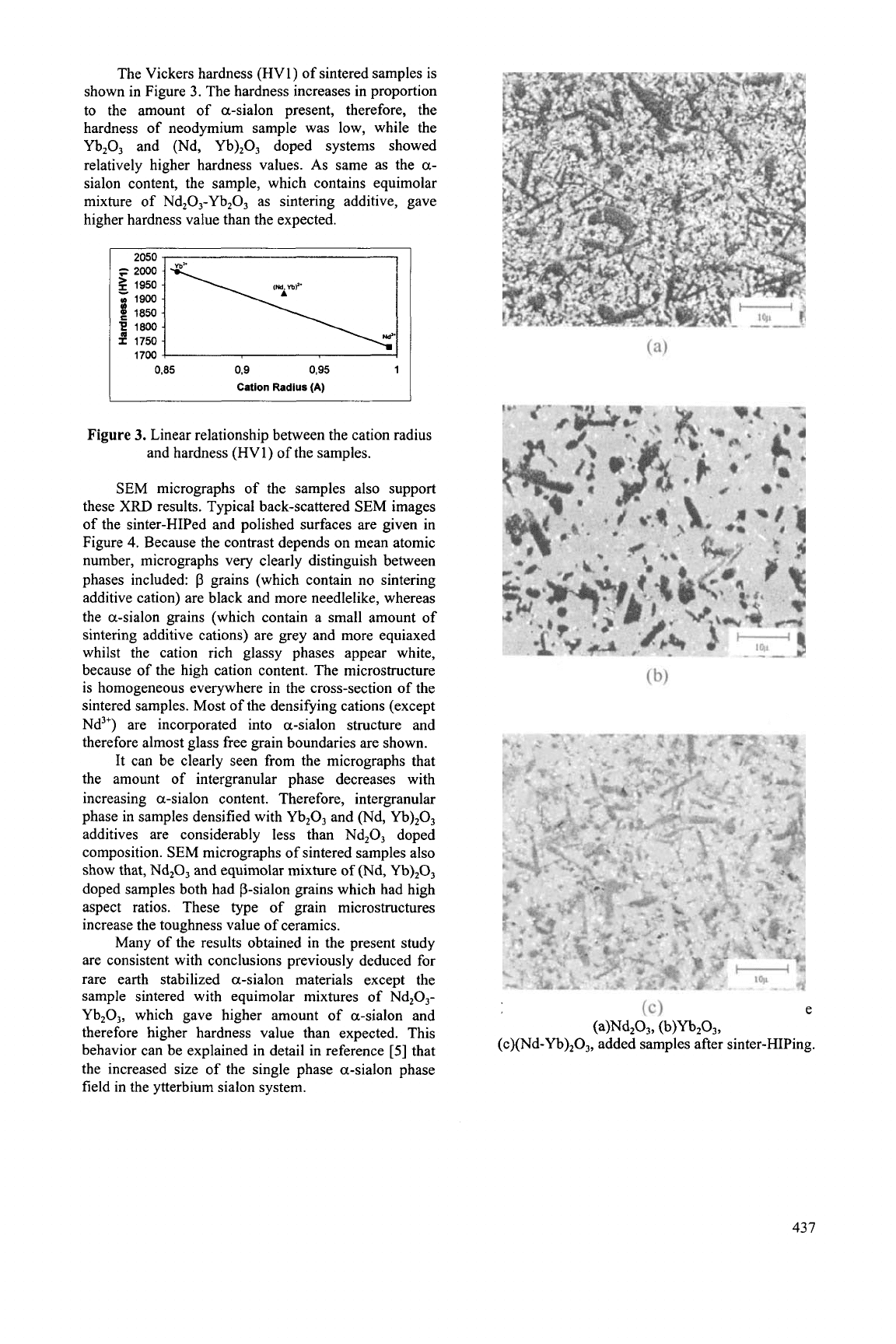
The Vickers hardness (HV1) of sintered samples is
shown
in
Figure
3.
The hardness increases in proportion
to the amount of a-sialon present, therefore, the
hardness of neodymium sample was low, while the
Yb203 and (Nd, Yb),03 doped systems showed
relatively higher hardness values.
As
same as the
a-
sialon content, the sample, which contains equimolar
mixture of Nd,O,-Yb,O, as sintering additive, gave
higher hardness value than the expected.
2050
$,
1950
a
1900
E
1850
??
1800
3
1750
1700
0.85
0.9 0.95
I
Cation
Radius
(A)
Figure
3.
Linear relationship between the cation radius
and hardness (HV1) of the samples.
SEM micrographs of the samples also support
these
XRD
results. Typical back-scattered SEM images
of the sinter-HIPed and polished surfaces are given in
Figure
4.
Because the contrast depends on mean atomic
number, micrographs very clearly distinguish between
phases included:
p
grains (which contain no sintering
additive cation) are black and more needlelike, whereas
the a-sialon grains (which contain a small amount of
sintering additive cations) are grey and more equiaxed
whilst the cation rich glassy phases appear white,
because
of
the high cation content. The microstructure
is homogeneous everywhere in the cross-section of the
sintered samples. Most of the densifying cations (except
Nd”) are incorporated into a-sialon structure and
therefore almost glass free grain boundaries are shown.
It can be clearly seen from the micrographs that
the amount of intergranular phase decreases with
increasing a-sialon content. Therefore, intergranular
phase in samples densified with Yb,03 and (Nd,
Yb),03
additives are considerably less than Nd203 doped
composition. SEM micrographs of sintered samples also
show that, Nd,O, and equimolar mixture
of
(Nd,
Yb),O,
doped samples both had p-sialon grains which had high
aspect ratios. These type of grain microstructures
increase the toughness value of ceramics.
Many of the results obtained in the present study
are consistent with conclusions previously deduced for
rare earth stabilized a-sialon materials except the
sample sintered with equimolar mixtures of Nd,O,-
Yb,O,, which gave higher amount of a-sialon and
therefore higher hardness value than expected. This
behavior can be explained in detail in reference
[5]
that
the increased size of the single phase a-sialon phase
field in the ytterbium sialon system.
(c>
Figure
4
Back-scattered SEM micrographs of the
(a)Nd,O,, (b)n203,
(c)(Nd-Yb),O,, added samples after sinter-HIPing.
437
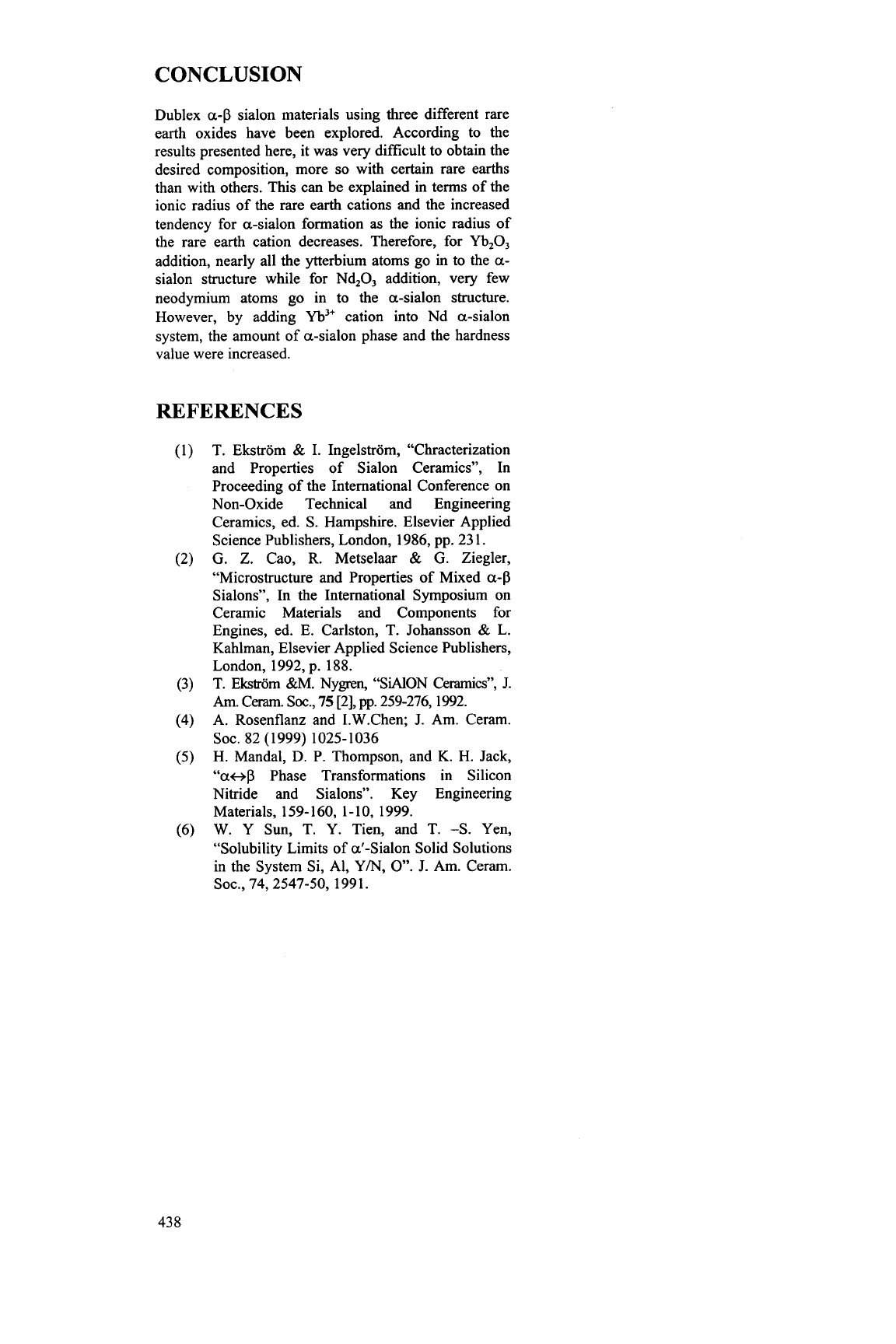
CONCLUSION
Dublex
a-p
sialon materials using three different rare
earth oxides have been explored. According to the
results presented here, it was very difficult to obtain the
desired composition, more
so
with certain rare earths
than with others. This can be explained in terms of the
ionic radius of the rare earth cations and the increased
tendency for a-sialon formation as the ionic radius of
the rare earth cation decreases. Therefore, for
Yb,O,
addition, nearly all the ytterbium atoms go in to the
a-
sialon structure while for Nd,03 addition, very few
neodymium atoms go in to the a-sialon structure.
However, by adding
Yb3+
cation into Nd a-sialon
system, the amount of a-sialon phase and the hardness
value were increased.
REFERENCES
T.
Ekstrom
&
I. Ingelstrom, “Chracterization
and Properties of Sialon Ceramics”, In
Proceeding of the International Conference on
Non-Oxide Technical and Engineering
Ceramics, ed.
S.
Hampshire. Elsevier Applied
Science Publishers, London, 1986, pp. 23 1.
G.
Z. Cao, R. Metselaar
&
G.
Ziegler,
“Microstructure and Properties of Mixed
a-P
Salons”, In the International Symposium on
Ceramic Materials and Components
for
Engines, ed. E. Carlston,
T.
Johansson
&
L.
Kahlman, Elsevier Applied Science Publishers,
London, 1992, p. 188.
T. Ekstriim &M. Nygren, “SiAlON
Ceramics”,
J.
Am.
Ceram.
Soc.,
75
[2], pp. 259-276,1992.
A. Rosenflanz and 1.W.Chen; J. Am. Ceram.
H. Mandal, D. P. Thompson, and K. H. Jack,
“a@
Phase Transformations in Silicon
Nitride and Salons”. Key Engineering
Materials, 159- 160, 1
-
10, 1999.
W. Y Sun, T.
Y.
Tien, and T.
-S.
Yen,
“Solubility Limits of a‘Sialon Solid Solutions
in the System Si, Al, Y/N,
0’.
J. Am. Ceram.
SOC. 82 (1999) 1025-1036
SOC., 74,2547-50, 199
1.
438
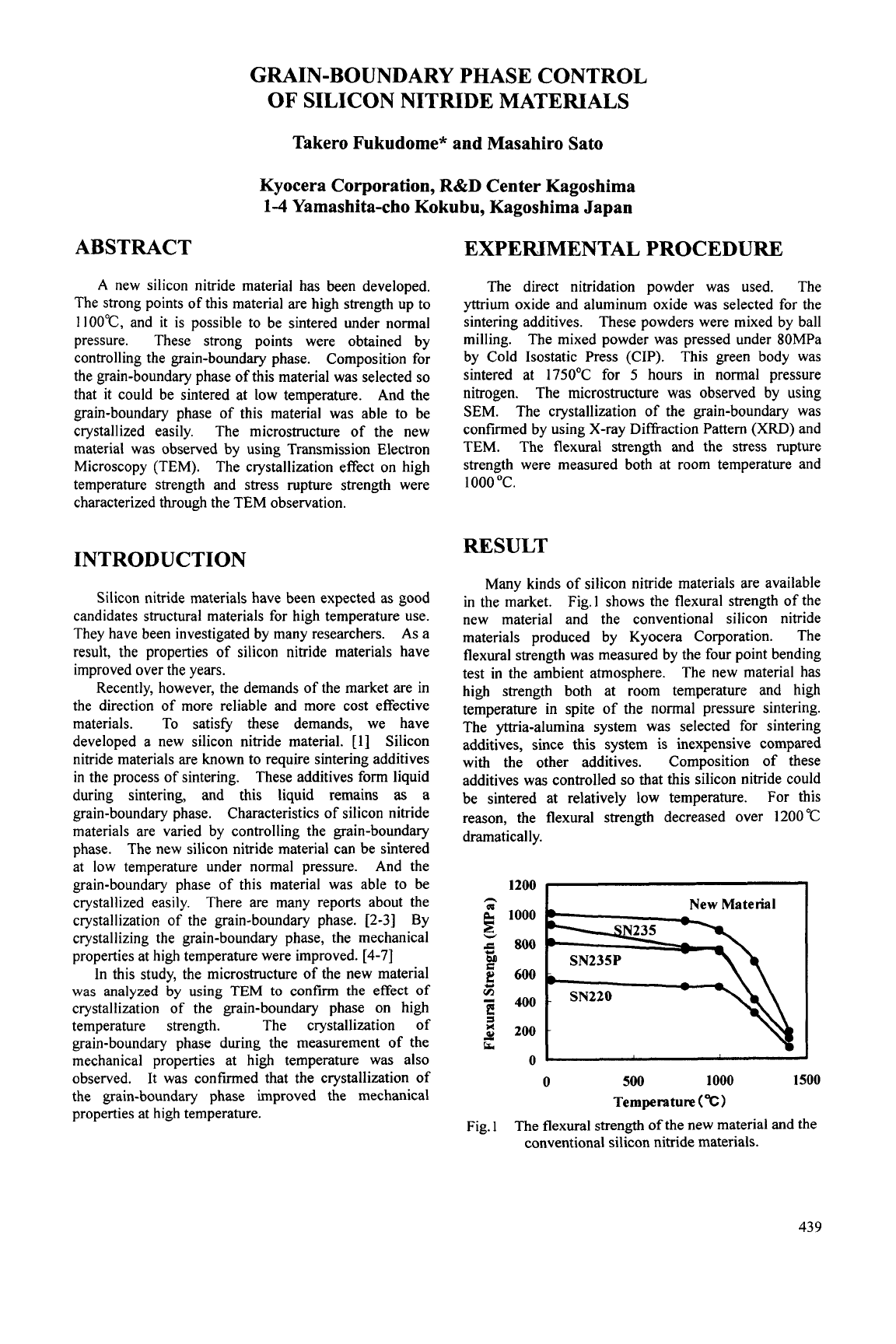
ABSTRACT
GRAIN-BOUNDARY PHASE CONTROL
OF
SILICON NITRIDE MATERIALS
Takero Fukudorne" and Masahiro
Sat0
Kyocera Corporation,
R&D
Center Kagoshirna
1-4
Yamashita-cho Kokubu, Kagoshima Japan
A
new silicon nitride material has been developed.
The strong points
of
this material are high strength up to
1
lOO"C,
and it is possible to be sintered under normal
pressure. These strong points were obtained by
controlling the grain-boundary phase. Composition for
the grain-boundary phase
of
this material was selected
so
that it could be sintered at low temperature.
And the
grain-boundary phase
of
this material was able to be
crystallized easily. The microstructure of the new
material was observed by using Transmission Electron
Microscopy (TEM). The crystallization effect on high
temperature strength and stress rupture strength were
characterized through the TEM observation.
INTRODUCTION
Silicon nitride materials have been expected as good
candidates structural materials for high temperature use.
They have been investigated by many researchers. As a
result, the properties
of
silicon nitride materials have
improved over the years.
Recently, however, the demands of the market are
in
the direction of more reliable and more cost effective
materials. To satisfy these demands, we have
developed a new silicon nitride material. [l] Silicon
nitride materials are known to require sintering additives
in
the process of sintering. These additives form liquid
during sintering, and this liquid remains
as
a
grain-boundary phase. Characteristics of silicon nitride
materials are varied by controlling the grain-boundary
phase. The new silicon nitride material can be sintered
at low temperature under normal pressure. And the
grain-boundary phase of this material was able to be
crystallized easily. There are many reports about the
crystallization
of
the grain-boundary phase.
[2-31
By
crystallizing the grain-boundary phase, the mechanical
properties at high temperature were improved. [4-71
In this study, the microstructure of the new material
was analyzed by using TEM to confirm the effect
of
crystallization of the grain-boundary phase on high
temperature strength. The crystallization of
grain-boundary phase during the measurement of the
mechanical properties at high temperature was also
observed. It was confirmed that the crystallization of
the grain-boundary phase improved the mechanical
properties at high temperature.
EXPERJMENTAL PROCEDURE
The direct nitridation powder was used. The
yttrium oxide and aluminum oxide was selected for the
sintering additives. These powders were mixed by ball
milling. The mixed powder was pressed under 80MPa
by Cold Isostatic Press (CIP). This green body was
sintered at 175OOC for
5
hours
in
normal pressure
nitrogen. The microstructure was observed by using
SEM. The crystallization
of
the grain-boundary was
confirmed by using X-ray Diffraction Pattern
(XRD)
and
TEM. The flexural strength and the stress rupture
strength were measured both at room temperature and
1000
"C.
RESULT
Many kinds of silicon nitride materials are available
in
the market.
Fig.] shows the flexural strength of the
new material and the conventional silicon nitride
materials produced by Kyocera Corporation. The
flexural strength was measured by the four point bending
test
in
the ambient atmosphere. The new material has
high strength both at room temperature and high
temperature in spite of the normal pressure sintering.
The yttria-alumina system was selected for sintering
additives, since this system
is
inexpensive compared
with the other additives. Composition of these
additives was controlled
so
that this silicon nitride could
be sintered at relatively low temperature. For this
reason, the flexural strength decreased over 1200
"C
dramatically.
1200
I
h
g
1000
v
5
800
Ti
2
200
W
600
400
z
a
r&
New Material
SN220
0'
0
500
1000
1500
Temperature(%)
The flexural strength
of
the new material and the
Fig.
1
conventional silicon nitride materials.
439
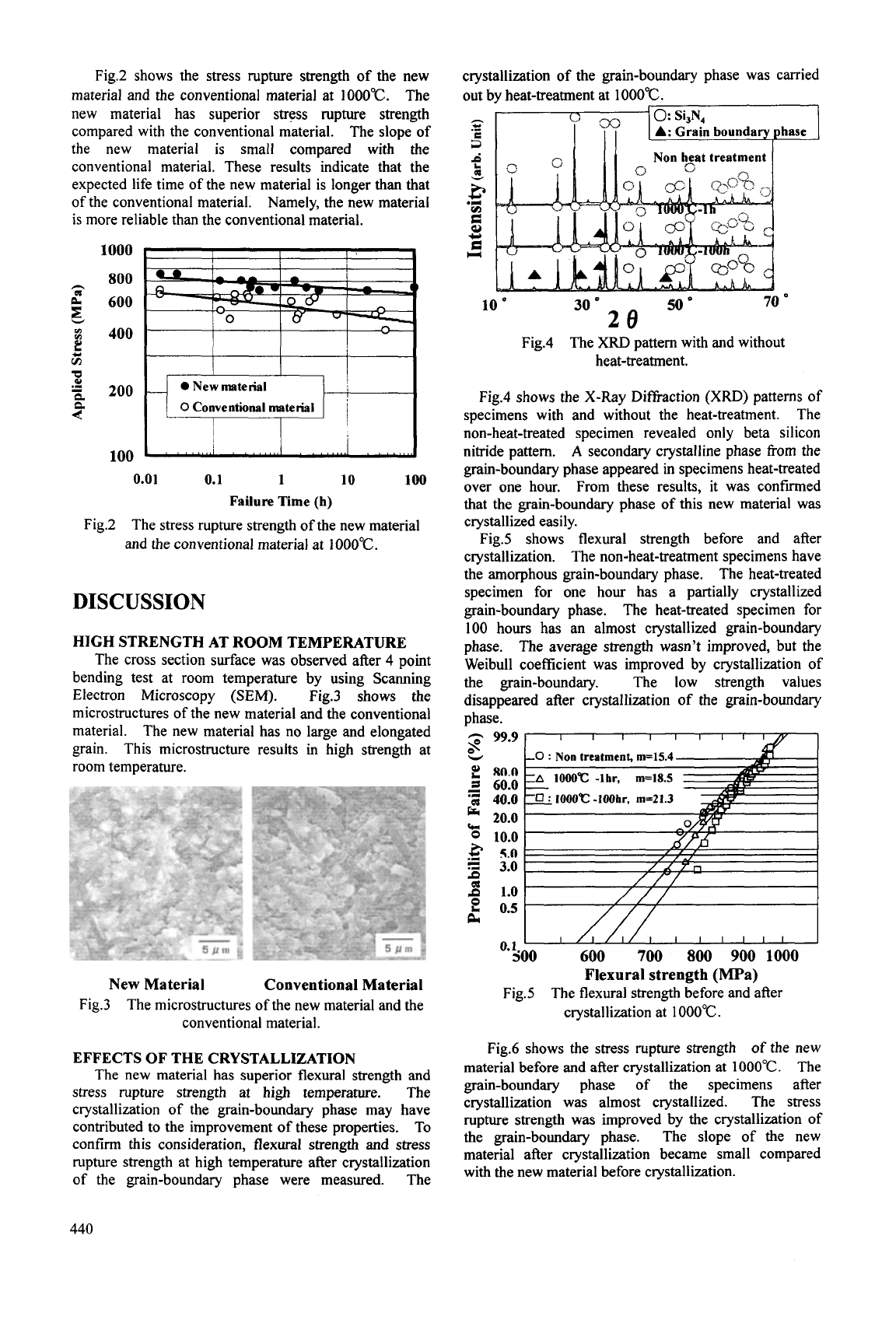
Fig.2 shows the stress rupture strength of the new
material and the conventional material at
1000°C.
The
new material has superior stress rupture strength
compared with the conventional material. The slope of
the new material is small compared with the
conventional material. These results indicate that the
expected life time
of
the new material is longer than that
of
the conventional material. Namely, the new material
is more reliable than the conventional material.
1000
I
I
I'
3
h
2
E
v)
E
z
800
600
400
0
New material
0
Conventional material
e
I
I
100
0.01
0.1
1
10
100
Failure Time
(h)
The stress rupture strength of the new material
Fig.2
and the conventional material at 1000°C.
DISCUSSION
HIGH STRENGTH AT ROOM TEMPERATURE
The cross section surface was observed after
4
point
bending test at room temperature by using Scanning
Electron Microscopy
(SEM).
Fig.3 shows the
microstructures of the new material and the conventional
material. The new material has no large and elongated
grain. This microstructure results
in
high strength at
room temperature.
New
Material Conventional Material
The microstructures of the new material and the
Fig.3
conventional material.
EFFECTS OF THE CRYSTALLIZATION
The new material has superior flexural strength and
stress rupture strength at high temperature. The
crystallization of the grain-boundary phase may have
contributed to the improvement
of
these properties.
To
confirm this consideration, flexural strength and stress
rupture strength at high temperature after crystallization
of the grain-boundary phase were measured. The
crystallization of the grain-boundary phase was carried
out by heat-treatment at 1000°C.
10
O
50
'
28
30
70
Fig.4 The XRD pattern with and without
heat-treatment.
Fig.4 shows the X-Ray Diffraction (XRD) patterns of
specimens with and without the heat-treatment. The
non-heat-treated specimen revealed only beta silicon
nitride pattern.
A
secondary crystalline phase
from
the
grain-boundary phase appeared in specimens heat-treated
over one hour. From these results, it was confirmed
that the grain-boundary phase of this new material was
crystallized easily.
Fig.5 shows flexural strength before and after
crystallization. The non-heat-treatment specimens have
the amorphous grain-boundary phase. The heat-treated
specimen for one hour has a partially crystallized
grain-boundary phase. The heat-treated specimen for
100
hours has an almost crystallized grain-boundary
phase. The average strength wasn't improved, but the
Weibull coefficient was improved by crystallization of
the grain-boundary. The low strength values
disappeared after crystallization of the grain-boundary
phase.
g
99.9
I I
IIIIII
W
0
:
Non
treatment,
1~15.4
1
20.0
Ccl
0
10.0
I
.d
0
4.n
s
s
1.0
3.0
I
0.5
0.1
&
600
700
800
900
1000
Flexural strength (MPa)
The flexural strength before and after
500
Fig.5
crystallization at 1000°C.
Fig.6 shows the stress rupture strength of the new
material before and after crystallization at
1000°C.
The
grain-boundary phase of the specimens after
crystallization was almost crystallized. The stress
rupture strength was improved by the crystallization of
the grain-boundary phase. The slope
of
the new
material after crystallization became small compared
with the new material before crystallization.
440
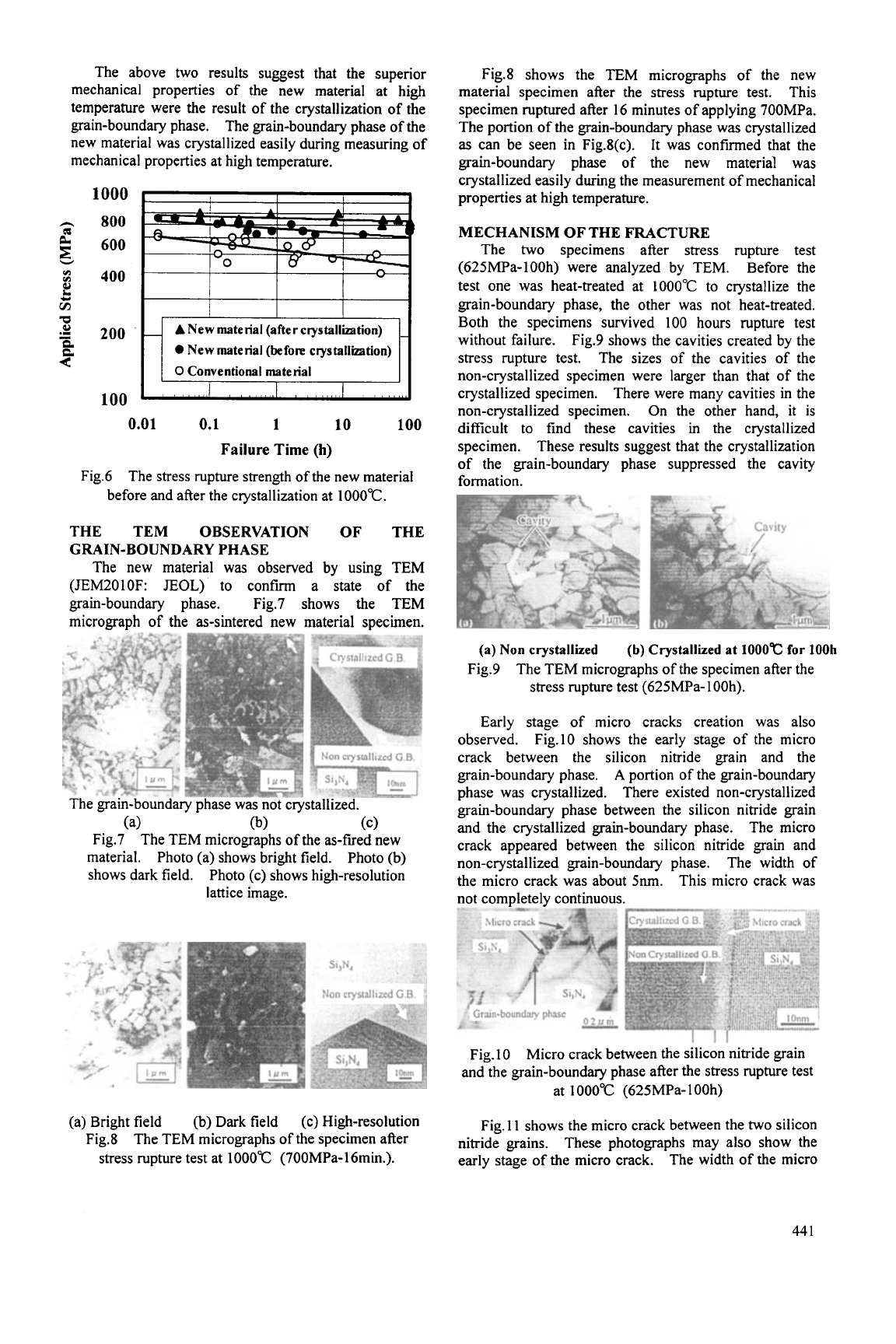
The above two results suggest that the superior
mechanical properties of the new material at high
temperature were the result
of
the crystallization
of
the
grain-boundary phase.
The grain-boundary phase
of
the
new material was crystallized easily during measuring of
mechanical properties at high temperature.
n
-
A
New material (after crystallization)
-
0
New material
(before
crystallization)
0
Conventional material
I
I I
1000
n
800
a"
600
z.
3
400
2
;;
z
200
?
n
t
I
I
100
0.01
0.1
1
10
100
Failure Time
(h)
The stress rupture strength of the new material
Fig.6
before and after the crystallization at 1000°C.
THE TEM OBSERVATION OF THE
The new material was observed by using TEM
(JEM201OF:
JEOL)
to confirm a state of the
grain-boundary phase. Fig.7 shows the TEM
micrograph
of
the as-sintered new material specimen.
GRAIN-BOUNDARY PHASE
The grain-boundary phase was not crystallized.
(a) (b) (c)
Fig.7 The TEM micrographs
of
the as-fired new
material. Photo (a) shows bright field. Photo (b)
shows dark field. Photo (c) shows high-resolution
lattice image.
(a) Bright field (b) Dark field (c) High-resolution
stress rupture test at 1000°C (700MPa-16min.).
Fig.8
The TEM micrographs of the specimen after
Fig.8 shows the TEM micrographs of the new
material specimen after the stress rupture test. This
specimen ruptured after 16 minutes
of
applying 700MPa.
The portion of the grain-boundary phase was crystallized
as can be seen in Fig.S(c). It was confirmed that the
grain-boundary phase of the new material was
crystallized easily during the measurement of mechanical
properties at high temperature.
MECHANISM
OF
THE FRACTURE
The two specimens after stress rupture test
(625MPa-1OOh) were analyzed by TEM. Before the
test one was heat-treated at
1000°C
to crystallize the
grain-boundary phase, the other was not heat-treated.
Both the specimens survived 100 hours rupture test
without failure. Fig.9 shows the cavities created by the
stress rupture test.
The sizes of the cavities of the
non-crystallized specimen were larger than that
of
the
crystallized specimen.
There were many cavities in the
non-crystallized specimen. On the other hand, it is
difficult to find these cavities in the crystallized
specimen. These results suggest that the crystallization
of the grain-boundary phase suppressed the cavity
formation.
(a)
Non
crystallized
(b)
Crystallized at
1000%
for
lOOh
Fig.9 The TEM micrographs of the specimen after the
stress rupture test (625MPa- 1 OOh).
Early stage of micro cracks creation was also
observed. Fig.10 shows the early stage of the micro
crack between the silicon nitride grain and the
grain-boundary phase.
A
portion of the grain-boundary
phase was crystallized. There existed non-crystallized
grain-boundary phase between the silicon nitride grain
and the crystallized grain-boundary phase.
The micro
crack appeared between the silicon nitride grain and
non-crystallized grain-boundary phase.
The width of
the micro crack was about
5nm.
This micro crack was
not completely continuous.
Fig. 10
Micro crack between the silicon nitride grain
and the grain-boundary phase after the stress rupture test
at
1000°C
(625MPa- 1 OOh)
Fig.
1 1
shows the micro crack between the two silicon
These photographs may also show the
The width of the micro
nitride grains.
early stage of the micro crack.
44
1
